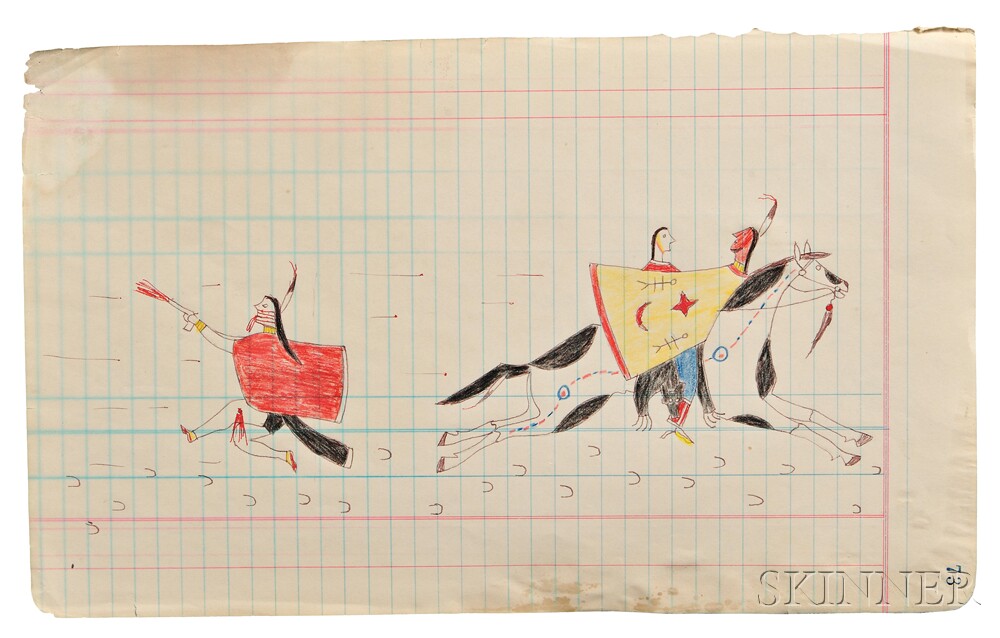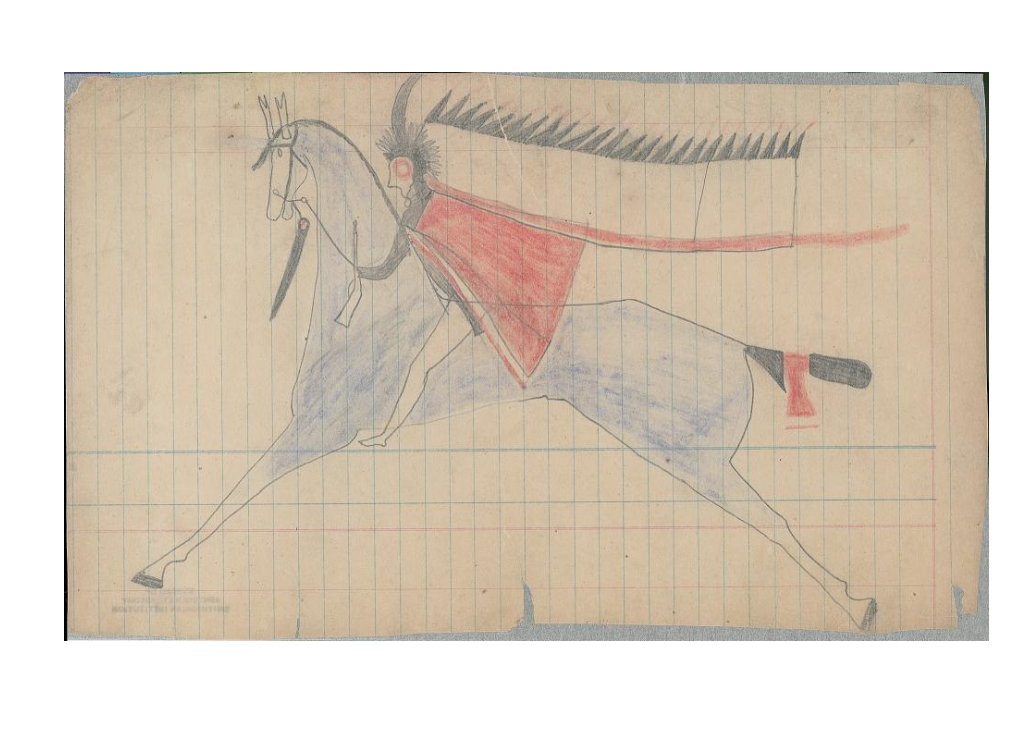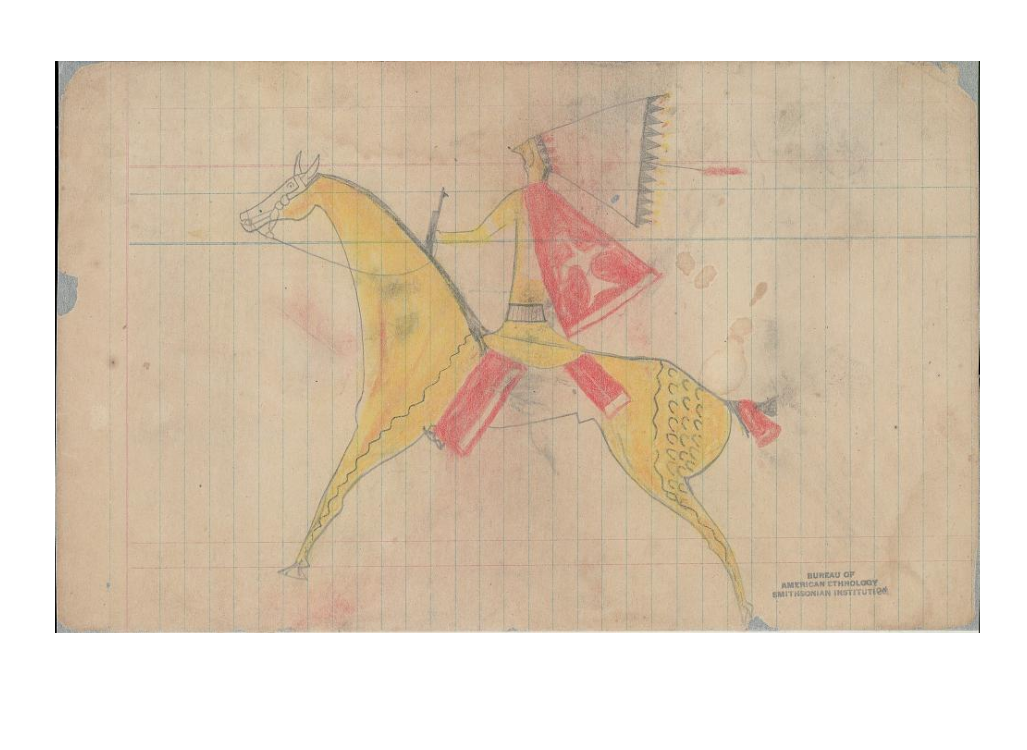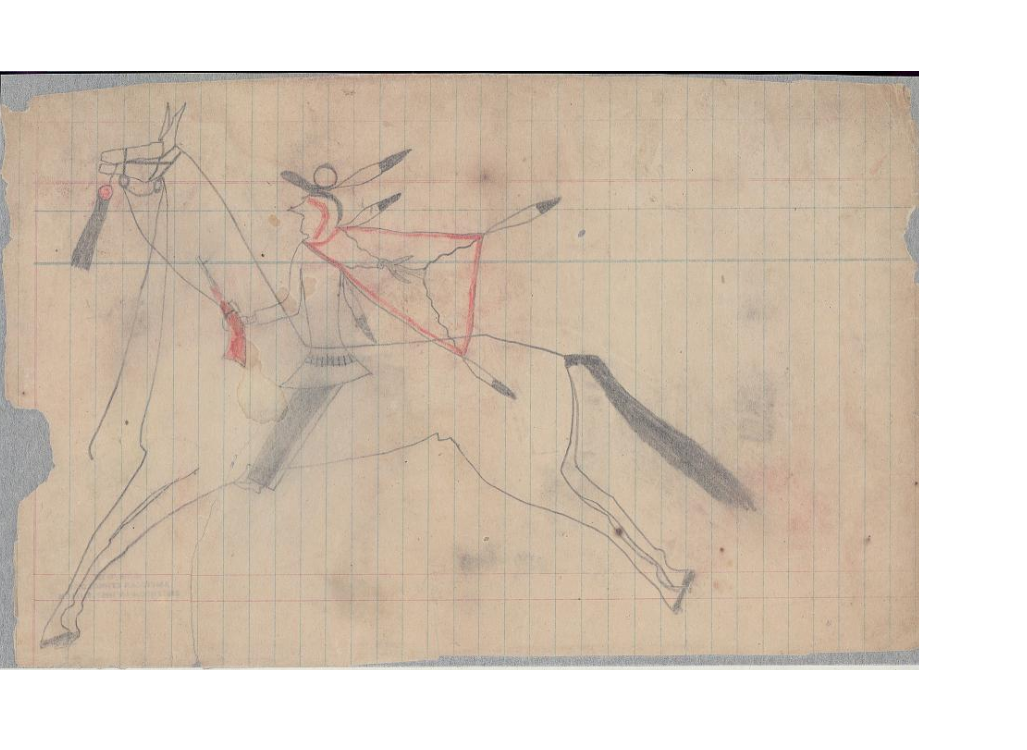|
|
Post by nicolas (carlo) on May 12, 2015 15:38:27 GMT -5
Hmm, I don't know Grahame, could be a quiver sling. You can see the upper part of his back, so it appears to be a sling. And sticking out of it may be the tip of a bow or an arrow? Yes, same red stroud cloth.
Great photo btw!
|
|
|
|
Post by rodthomas on May 12, 2015 17:45:40 GMT -5
Was just working with some Miller photos for the White Swan biography and thought I'd check something and saw an addition to this topic. It is not a cape as Carlo notes. I'm suggesting it is his bundle - leader/pipe/horse - that he wears. I've attached the Miller photo of Curley's tipi with the bundle attached to a guy rope as was the custom. Note the eagle feathers on the ends as well as the light strip on the edges. The feathers and the light stripe are visible with careful inspection of the mounted Curley photo (yes, by Miller). He is also wearing it in the 1903 photo of him and White Swan at the Sheridan Fair.    I'll try to get a better image of the mounted Curley and post tomorrow. Regards, Rod... |
|
|
|
Post by grahamew on May 13, 2015 13:06:20 GMT -5
Ahhhh, judging from the other photos, I agree with you.
|
|
|
|
Post by rodthomas on May 14, 2015 11:46:47 GMT -5
|
|
|
|
Post by grahamew on May 14, 2015 13:46:54 GMT -5
Thanks, Rod. Excellent work. I love this kind of stuff!
|
|
|
|
Post by gregor on Jun 26, 2015 6:42:50 GMT -5
Hi, back to the Red War Capes.
I have a very bad copy of an American Anthropologist essay from 1909, dealing with the use of Buffalo wool. Author? In this essay I found this:
The earliest reference to its use [Buffalo wool] by the Illinois necessarily appears in Marquette’s Relation. When he reached the villages of the Illinois, soon after the discovery of the upper Mississippi on June 17, 1673, he entered in his journal this interesting statement:
“ …. when the Illinois depart to go to war, the whole village must be notified by a loud shout, which is uttered at the doors of their cabins, the night and morning before their departure. The captains are distinguished from the warriors by wearing red scarfs. These are made with considerable skill, from the hair of …. wild cattle [buffalo] .” (Source: Jesuit Relations, Thwaites ed., vol. 59 ?).
Maybe this is the origin of the above discussed red war capes. Any ideas?
Toksha
Gregor
|
|
|
|
Post by nicolas (carlo) on Jun 26, 2015 14:04:47 GMT -5
Ooh, nice find Gregor. Good to see some confirmation of my earlier assumption that these capes were the badge of a leading warrior.
Still irks me a bit though that no supporting evidence has been found of its significance among the otherwise so well documented Lakotas!
|
|
|
|
Post by grahamew on Jun 27, 2015 11:11:24 GMT -5
Excellent work, Gregor.
|
|
|
|
Post by nicolas (carlo) on Sept 24, 2015 20:06:10 GMT -5
One more interesting detail to add to the discussion. On page 100 in Robert Clark's Killing of Crazy Horse, Bill Garnett claims that in battle Crazy Horse "always wore a colt hide as a cape." Don't know if it's the same cape as we are discussing here, though.
|
|
|
|
Post by grahamew on Oct 20, 2015 15:20:19 GMT -5
Another red war cape - and one decorated with dragonflies, a star and the moon. I can't quite work out whether the man on the right is rescuing someone or capturing a woman. The leggings he wears (or is the captive?) are paneled, like those worn by the Crow:  It's one of four ledger drawings on the Skinner auction site, credited to a Lakota late 19th century. One of the drawings has the name and glyph Sitting Bear. The artist is again, I think His Fight or Jaw. |
|
|
|
Post by grahamew on Nov 30, 2015 14:32:09 GMT -5
There's a great Lakota ledger here at the SIRIS site: collections.si.edu/search/results.htm?q=set_name:%22Book+of+drawings+by+anonymous+Lakota+artists%22Dated about 1876, the plates show the usual war vignettes, courting and other social scenes, but also some more overtly spiritual aspects of Lakota life. There is some incredible ethnographic detail, but unfortunately, there isn't much information about them and there are no name glyphs. However, there are names given in the actual ledger - the store keeper's log: "Drawings of scenes of warfare, horse raids, courting, and ceremonies on pages of a ledger book, now disbound, covers not retained. Several pages bear storekeeper's (?) accounts of agricultural implements issued, in the names of several Indians. Dates on these sheets range 1873- July 1876. On one sheet the words "Pine Ridge, D. T." are written in pencil, now faded, followed by other writing in the Dakota language (11001600b). One phrase on this sheet ("miye heraka kin") seems to identify one artist as The Male Elk. Page 47 bears the words "waluta tokala ala eciyapiye" ("red root fox they call him"). The drawings appear to be by multiple artists, probably Teton Lakota. An accompanying letter by James Mooney (1906) gives his opinion of the drawings, which were sent to him for comment. He believed them to be Western Sioux, of "about 30 years ago." Names given in store keeper's ledger, (Pine Ridge, D. T.?): Black Hawk, The, Bear Eagle, Bone Necklace Son, Charger, Dog Eagle, Fats Son, The, Frozen Foot, Good Thunder, Half, The, Handle, Hawk, The, Iron Horse, La Barge, Tom, Laravi, Alex, Martin, Lewis, Meshel, One That Hurts Himself, The, Painted Arm, The, Pole, The, Rattler, The, Speach Maker, Spotted Horse, Standing Bear, Straight Head, Two Tails, Whirlwind, White Stone." collections.si.edu/search/detail/ead_collection:sova-naa-ms39d1?q=james+mooney+ledger&record=209&hlterm=james%2Bmooney%2Bledger&inline=trueAnyhow, my point here is to point out the depiction of several men wearing war capes - two of which have been posted by Allen a couple of pages back:    And last and most relevant to this thread: a man wearing a red cape AND red turban:  |
|
|
|
Post by kingsleybray on Nov 30, 2015 17:15:02 GMT -5
The ledger book is very interesting. I haven't studied them exhaustively, but many of the personal names of people written in the book are Cheyenne River Agency names -- and quite distinctive ones. Examples: Man that Hurts Himself (Sans Arc), Painted Arm (Sihasapa), The Speech Maker (Sans Arc), Bone Necklace Son -- all these men are listed in Cheyenne River Agency censuses from 1875 through 1877. Moreover, the distinctive style of painting of the Horse Dance horse masks (page 7/9 of the slideshow images) is similar -- I'd say the same artist -- as the paintings of Black Hawk (Sans Arc), reproduced in this book: www.amazon.co.uk/Spirit-Beings-Sun-Dancers-Vision/dp/0807614653The paintings in the Berlo book are dated winter 1880-81. The style in the Horse Dance paintings in the SIRIS ledger seem less mature -- possibly painted a year or two earlier? |
|
|
|
Post by grahamew on Dec 1, 2015 3:30:10 GMT -5
I haven't looked at every drawing, but the impression I get is that the only enemies depicted are Crows, so we're certainly talking about a more northern group; without looking more closely, aside from a man making off with a cavalry horse and another with a team of mules, I'm not sure there's any conflict with whites (though this, of course, may be diplomatic) - something else this has in common with the Black Hawk drawings. I was also struck by the similarity between the horse dance masks and the drawings in the Black Hawk ledger. On the other hand, I notice Mooney points out how few shields are on display in this ledger, yet there are many in the Black Hawk book.
|
|
|
|
Post by kingsleybray on Dec 1, 2015 6:37:20 GMT -5
unlike the ledger published by Berlo, which is obviously the work of one very talented Lakota artist (Black Hawk), we obviously have more than one artist in the new SIRIS ledger. But I looked at those horse dance/vision horses and was more convinced they're the work of Black Hawk. I realise we're getting off topic
|
|
|
|
Post by grahamew on Dec 1, 2015 8:19:27 GMT -5
Not at all. Fascinating stuff as usual, Kingsley.
|
|